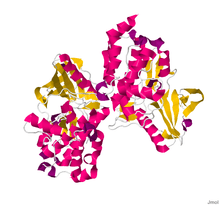Myosin light-chain kinase
| myosin light-polypeptide kinase, smooth muscle | |
|---|---|
| Identifiers | |
| Symbol | MYLK |
| Entrez | 4638 |
| HUGO | 7590 |
| OMIM | 600922 |
| RefSeq | NM_053025 |
| UniProt | Q15746 |
| Other data | |
| EC number | 2.7.11.18 |
| Locus | Chr. 3 qcen-q21 |
| myosin light-chain kinase 2, skeletal muscle | |
|---|---|
 | |
| Identifiers | |
| Symbol | MYLK2 |
| Entrez | 85366 |
| HUGO | 16243 |
| OMIM | 606566 |
| RefSeq | NM_033118 |
| UniProt | Q9H1R3 |
| Other data | |
| Locus | Chr. 20 q13.31 |
| myosin light-chain kinase 3, cardiac | |
|---|---|
| Identifiers | |
| Symbol | MYLK3 |
| Entrez | 91807 |
| HUGO | 29826 |
| OMIM | 612147 |
| RefSeq | NM_182493 |
| UniProt | Q32MK0 |
| Other data | |
| Locus | Chr. 16 q11.2 |
| Human Myosin Light-Chain Kinase | |
|---|---|
 The Crystal Structure of the Human Myosin Light Chain Kinase Loc340156.[2] | |
| Identifiers | |
| Symbol | MYLK4 |
| Entrez | 340156 |
| HUGO | 27972 |
| RefSeq | NM_001012418 |
| UniProt | Q86YV6 |
Myosin light-chain kinase also known as MYLK or MLCK is a serine/threonine-specific protein kinase that phosphorylates a specific myosin light chain, namely, the regulatory light chain of myosin II.[3]
Isoforms
Four different MLCK isoforms exist:[4]
Function
These enzymes are important in the mechanism of contraction in muscle. Once there is an influx of calcium cations (Ca2+) into the muscle, either from the sarcoplasmic reticulum or from the extracellular space, contraction of smooth muscle fibres may begin. First, the calcium will bind to calmodulin. This binding will activate MLCK, which will go on to phosphorylate the myosin light chain at serine residue 19. This will enable the myosin crossbridge to bind to the actin filament and allow contraction to begin (through the crossbridge cycle). Since smooth muscle does not contain a troponin complex, as striated muscle does, this mechanism is the main pathway for regulating smooth muscle contraction. Reducing intracellular calcium concentration inactivates MLCK but does not stop smooth muscle contraction since the myosin light chain has been physically modified through phosphorylation(and not via ATPase activity). To stop smooth muscle contraction this change needs to be reversed. Dephosphorylation of the myosin light chain (and subsequent termination of muscle contraction) occurs through activity of a second enzyme known as myosin light-chain phosphatase (MLCP).
See also
References
- ↑ "RCSB Protein Data Bank - Structure Summary for 3KF9 - Crystal structure of the SdCen/skMLCK complex".
- ↑ "RCSB Protein Data Bank - Structure Summary for 2X4F - The Crystal Structure of the Human Myosin Light Chain Kinase Loc340156.".
- ↑ Gao Y, Ye LH, Kishi H, Okagaki T, Samizo K, Nakamura A, Kohama K (June 2001). "Myosin light chain kinase as a multifunctional regulatory protein of smooth muscle contraction". IUBMB Life. 51 (6): 337–44. doi:10.1080/152165401753366087. PMID 11758800.
- ↑ Manning G, Whyte DB, Martinez R, Hunter T, Sudarsanam S (December 2002). "The protein kinase complement of the human genome". Science. 298 (5600): 1912–34. doi:10.1126/science.1075762. PMID 12471243.
Further reading
- Strausberg RL, Feingold EA, Grouse LH, et al. (2003). "Generation and initial analysis of more than 15,000 full-length human and mouse cDNA sequences.". Proc. Natl. Acad. Sci. U.S.A. 99 (26): 16899–903. doi:10.1073/pnas.242603899. PMC 139241
 . PMID 12477932.
. PMID 12477932. - Gerhard DS, Wagner L, Feingold EA, et al. (2004). "The status, quality, and expansion of the NIH full-length cDNA project: the Mammalian Gene Collection (MGC).". Genome Res. 14 (10B): 2121–7. doi:10.1101/gr.2596504. PMC 528928
 . PMID 15489334.
. PMID 15489334. - Clayburgh DR, Rosen S, Witkowski ED, et al. (2005). "A differentiation-dependent splice variant of myosin light chain kinase, MLCK1, regulates epithelial tight junction permeability.". J. Biol. Chem. 279 (53): 55506–13. doi:10.1074/jbc.M408822200. PMC 1237105
 . PMID 15507455.
. PMID 15507455. - Wang F, Graham WV, Wang Y, et al. (2005). "Interferon-gamma and tumor necrosis factor-alpha synergize to induce intestinal epithelial barrier dysfunction by up-regulating myosin light chain kinase expression.". Am. J. Pathol. 166 (2): 409–19. doi:10.1016/S0002-9440(10)62264-X. PMC 1237049
 . PMID 15681825.
. PMID 15681825. - Russo JM, Florian P, Shen L, et al. (2005). "Distinct temporal-spatial roles for rho kinase and myosin light chain kinase in epithelial purse-string wound closure.". Gastroenterology. 128 (4): 987–1001. doi:10.1053/j.gastro.2005.01.004. PMC 1237051
 . PMID 15825080.
. PMID 15825080. - Shimizu S, Yoshida T, Wakamori M, et al. (2006). "Ca2+-calmodulin-dependent myosin light chain kinase is essential for activation of TRPC5 channels expressed in HEK293 cells.". J. Physiol. (Lond.). 570 (Pt 2): 219–35. doi:10.1113/jphysiol.2005.097998. PMC 1464317
 . PMID 16284075.
. PMID 16284075. - Kim MT, Kim BJ, Lee JH, et al. (2006). "Involvement of calmodulin and myosin light chain kinase in activation of mTRPC5 expressed in HEK cells.". Am. J. Physiol., Cell Physiol. 290 (4): C1031–40. doi:10.1152/ajpcell.00602.2004. PMID 16306123.
- Kimura K, Wakamatsu A, Suzuki Y, et al. (2006). "Diversification of transcriptional modulation: large-scale identification and characterization of putative alternative promoters of human genes.". Genome Res. 16 (1): 55–65. doi:10.1101/gr.4039406. PMC 1356129
 . PMID 16344560.
. PMID 16344560. - Connell LE, Helfman DM (2007). "Myosin light chain kinase plays a role in the regulation of epithelial cell survival.". J. Cell. Sci. 119 (Pt 11): 2269–81. doi:10.1242/jcs.02926. PMID 16723733.
- Seguchi O, Takashima S, Yamazaki S, et al. (2007). "A cardiac myosin light chain kinase regulates sarcomere assembly in the vertebrate heart.". J. Clin. Invest. 117 (10): 2812–24. doi:10.1172/JCI30804. PMC 1978424
 . PMID 17885681.
. PMID 17885681.
External links
- MYLK protein, human at the US National Library of Medicine Medical Subject Headings (MeSH)
- Myosin-Light-Chain Kinase at the US National Library of Medicine Medical Subject Headings (MeSH)
This article incorporates text from the United States National Library of Medicine, which is in the public domain.